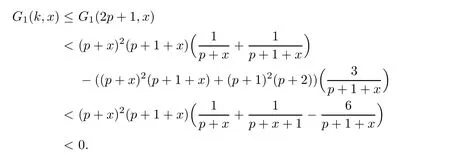A GENERALIZATION OF GAUSS-KUZMIN-LéVY THEOREM?
Peng SUN(孫鵬)
China Economics and Management Academy,Central University of Finance and Economics,Beijing 100081,China
E-mail:sunpeng@cufe.edu.cn
Abstract We prove a generalized Gauss-Kuzmin-Lévy theorem for the generalized Gauss transformation
Key words Gauss transformation;transfer operator;Gauss’problem;Hurwitz zeta function
1 Introduction
Let p be a positive integer.We consider the following generalized Gauss transformation on[0,1]:

where{x}is the fractional part of x.Such transformations were first introduced in[3](the associated continued fractions had appeared in[2])and also studied in[7,8,11].For every p,Tphas a unique absolutely continuous ergodic invariant measure,
where m is the Lebesuge measure on[0,1].Equivalently,


is the unique continuous eigenfunction of the transfer operator corresponding to the eigenvalue 1.We remark that G1is the so-called Gauss-Kuzmin-Wirsing operator introduced in[5].Detailed discussion on this operator can be found in[4].
Denote

Let

Gauss has shown that

In 1812,he proposed the problem to estimate

The first solution was given by Kuzmin[6],who showed in 1928 that

as n → ∞ for some q∈ (0,1).In 1929,Lévy[9]established

In this article,we would like to follow an approach in[10]to generalize Lévy’s result for all
Theorem 1.1For every positive integer p and every x∈[0,1],

where

and

are the Hurwitz zeta functions.
Remark 1.2We would like to thank an anonymous referee from whom we learned that there is a similar result in[7,Theorem 1.1(ii)].Compared to it,we have a different approach and the main novelty of Theorem 1.1 is the explicit expression of Qp,which is an upper bound of the exponential rate of decay for

As a generalization of Lévy’s result[9]onit is natural to expect thatalso decays exponentially.Our motivation is to see how the rate depends on p.The estimate we have for Qpshows that Qp→0 as p→ ∞.Furthermore,it provides the first order termSo,generally it is faster that ?p,nconverges to Φpas p grows.This is the most interesting fact we observe in this work.
2 Proof of the Theorem
For fixed p,we have

and

This recursive formula implies that ?nis differentiable(actually analytic)and hence

So,it is enough to study the operator Gp.Note that(1.1)holds if

We can actually show a more general result:
Theorem 2.1Let f∈C1([0,1])such that

Then,for every positive integer p and every x∈[0,1],we have

ProofFix p.Let

Then,

where

Note that

So

Moreover,for every k≥p and x∈[0,1],

Note that gn∈C1[0,1].Let

be the norm of gnin C1[0,1].Then,for every k≥p and x∈[0,1],we obtain

This implies that

converges absolutely and the sequence of its partial sums converges uniformly.Hence,we have

for some τk∈ [p,k],k=p,p+1,···.
Let k·k be the maximum norm on C[0,1],the space of all continuous functions on[0,1],andthat is,

Then,

for

and

for every k≥p.
Let

If p≤k≤2p,then


If k≥2p+1,then

But for k≥2p+1,

So,for k≥2p+1,

Therefore,for all integers k≥p and all x∈[0,1],we have G(k,x)<0.Equivalently,Hence,


We will show in Theorem 3.1 that,which implies that,there is a constant c∈R such that

We note for any integrable function ψ,

So,for all n,

Hence in(2.2)we must have

Remark 2.2A direct corollary of Theorem 2.1 is

However,the idea of the proof actually relies on the knowledge that ηp(x)is invariant of Gp:We presume that(2.3)holds.So,we make the substitution(2.1)and consider the derivative of
3 Estimate of the Constant
Now,we evaluate Qp.If p=1,then Q1=2ζ(3)? ζ(2)<0.76,where ζ(n)is the Riemann zeta function.For p≥2,the following estimate is not too bad.
Theorem 3.1For every positive integer p,

Remark 3.2This implies that

Applying results on asymptotic expansions of Hurwitz zeta functions or polygamma functions(cf.[1]),we actually have

ProofFix p.For

we have

and

that is,

Hence,

For

we have

and

that is,

Hence,

Therefore,

Meanwhile,

Hence,

 Acta Mathematica Scientia(English Series)2018年3期
Acta Mathematica Scientia(English Series)2018年3期
- Acta Mathematica Scientia(English Series)的其它文章
- HELICAL SYMMETRIC SOLUTION OF 3D NAVIER-STOKES EQUATIONS ARISING FROM GEOMETRIC SHAPE OF THE BOUNDARY?
- INITIAL BOUNDARY VALUE PROBLEM FOR A NONCONSERVATIVE SYSTEM IN ELASTODYNAMICS?
- LONG-TIME DYNAMICS OF THE STRONGLY DAMPED SEMILINEAR PLATE EQUATION IN RN?
- STABILITY OF TRAVELING WAVES IN A POPULATION DYNAMIC MODEL WITH DELAY AND QUIESCENT STAGE?
- NONLINEAR STABILITY OF VISCOUS SHOCK WAVES FOR ONE-DIMENSIONAL NONISENTROPIC COMPRESSIBLE NAVIER–STOKES EQUATIONS WITH A CLASS OF LARGE INITIAL PERTURBATION?
- THE EVENTUALLY DISTANCE MINIMIZING RAYS IN MODULI SPACES?
